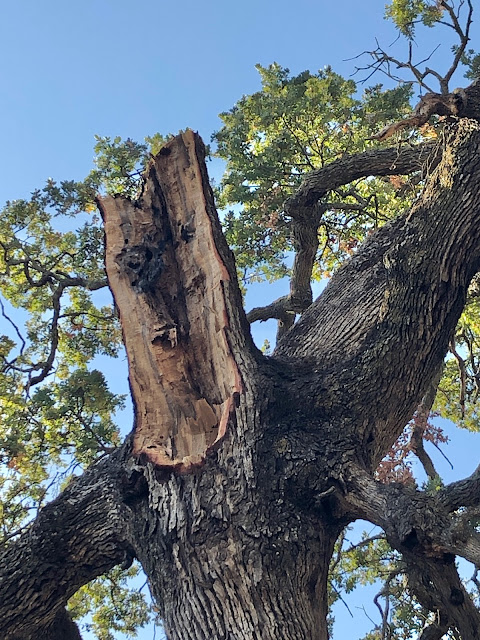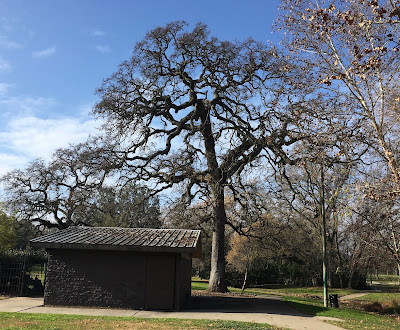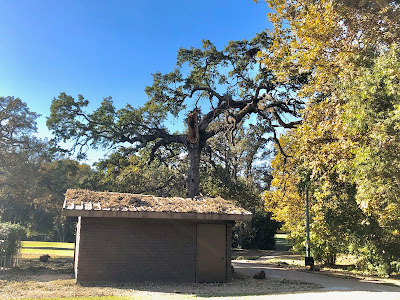
They are more vulnerable than we realize

|
|
This gash was left after a huge limb broke off a blue oak
recently. (Photos: Kathy Morrison)
|
It takes a long time for a mature tree to die.
Yet we've all seen it, maybe without noticing the symptoms. The canopy grows sparse, or it starts dropping leaves and twigs at the wrong time of year, or there are holes all over the trunk. Years may go by before a windstorm blows it over. With the shade in that area now gone, the plants nearby are affected, and maybe the character of the site changes.
Trees are easily taken for granted.
I was reminded of this earlier in the week when I strolled over to our neighborhood park. I hadn't been in awhile, and I always enjoy seeing the changes that fall brings. Also, a flock of magpies lives there, and the birds are amusing to watch.
This park has been part of my landscape for nearly 25 years -- I've photographed most of the trees at one time or another -- so it was a bit of a shock to see a giant wound on my favorite blue oak. This tree stands probably 50 feet tall, just to the side of a small park building that formerly was a restroom and now is a utility room for the park district. A small muddy creek runs nearby about 10 feet away.

|
|
Here's what the full-size blue oak looked like in January 2018.
|
Blue oaks ( Quercus douglasii ) are tough native trees. In the book "Oaks of California" (Cachuma Press), the authors note, "Although other oaks are resistant to drought, few of them combine all the mechanisms of opportunism, conservation, tolerance and resiliency that are known in blue oak." The tree also is one of the "Shady Eighty," trees recommended by the Sacramento Tree Foundation. This particular specimen undoubtably was growing here long before the neighborhood was built in the 1960s.
So why did this giant lose such a big section at this time?

|
|
And here it is earlier this week.
|
This likely is evidence of borer insects, which years ago sensed a stressed tree and made this oak their home. Clearwing moths are among the insects whose larvae leave dime-size tunnels in trees, but it could have been another pest. SacTree notes of the blue oak: "Wood and root rots occur, borers and chewing insects can also be a problem."
Whatever caused the branch to weaken and break, this tree may not survive the injury. The remaining canopy, with the exception of one other smaller branch, still sported the tree's distinctive blue-green leaves. But since the tree stands next to a public walkway, it may pose too much of a liability to remain where it's grown for so many years. If it goes, I will miss it. Its fate also serves as an excellent reminder to care for our trees, before we're forced to notice them.
If you have questions about caring for any trees, not just oaks, the Sacramento Tree Foundation is an excellent source of information: sactree.org
Comments
0 comments have been posted.Sacramento Digs Gardening to your inbox.
Sites We Like
Garden Checklist for week of April 21
This week there’s plenty to keep gardeners busy. With no rain in the immediate forecast, remember to irrigate any new transplants.
* Weed, weed, weed! Get them before they flower and go to seed.
* April is the last chance to plant citrus trees such as dwarf orange, lemon and kumquat. These trees also look good in landscaping and provide fresh fruit in winter.
* Smell orange blossoms? Feed citrus trees with a low dose of balanced fertilizer (such as 10-10-10) during bloom to help set fruit. Keep an eye out for ants.
* Apply slow-release fertilizer to the lawn.
* Thoroughly clean debris from the bottom of outdoor ponds or fountains.
* Spring brings a flush of rapid growth, and that means your garden is really hungry. Feed shrubs and trees with a slow-release fertilizer. Or mulch with a 1-inch layer of compost.
* Azaleas and camellias looking a little yellow? If leaves are turning yellow between the veins, give them a boost with chelated iron.
* Trim dead flowers but not leaves from spring-flowering bulbs such as daffodils and tulips. Those leaves gather energy to create next year's flowers. Also, give the bulbs a fertilizer boost after bloom.
* Pinch chrysanthemums back to 12 inches for fall flowers. Cut old stems to the ground.
* Mulch around plants to conserve moisture and control weeds.
* From seed, plant beans, beets, cantaloupes, carrots, corn, cucumbers, melons, radishes and squash.
* Plant onion sets.
* In the flower garden, plant seeds for asters, cosmos, celosia, marigolds, salvia, sunflowers and zinnias.
* Transplant petunias, zinnias, geraniums and other summer bloomers.
* Plant perennials and dahlia tubers for summer bloom.
* Mid to late April is about the last chance to plant summer bulbs, such as gladiolus and tuberous begonias.
* Transplant lettuce seedlings. Choose varieties that mature quickly such as loose leaf.